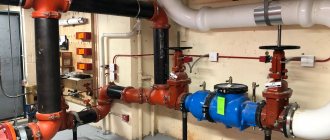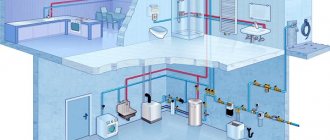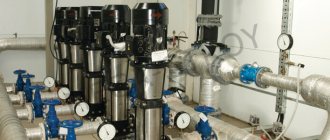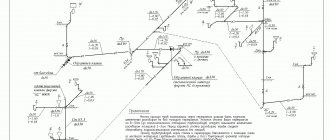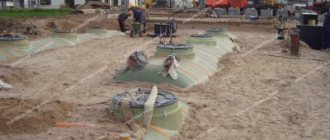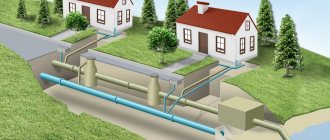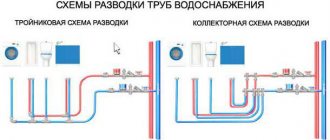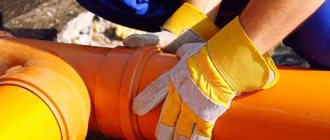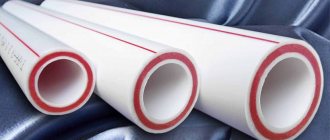Timing and cost of implementation of the sewerage and water supply system project
On our website there is a detailed price list, which indicates the cost of installation of water supply for objects of various purposes and of various sizes. In general, the final price depends on a number of factors:
- Scope and features of the water supply system. The complexity and price of installation of sewerage and water supply depend on the intended purpose of the system. We implement projects for drinking water, watering, fire protection and industrial purposes.
- Water supply system source parameters. The requirements for the power and performance of pumping equipment depend on this.
- Complex solutions. A turnkey water supply and sewerage system costs less in total than ordering the design, installation and supply of network components separately.
The cost of installing sewerage and water supply is calculated taking into account the optimal ratio of price and quality of materials, as well as necessary and additional work. The experience of our specialists allows us to make the most advantageous offer for any property, such as a private house, shopping center, industrial building, etc.
Installation of water supply and sewerage systems does not always require a one-time payment. If the installation is carried out by unskilled workers, then over time you will have to invest in correcting errors and troubleshooting problems.
The Obion company invites you to order turnkey installation of a water supply system for your home in Moscow and receive reliable and energy-efficient communications at a competitive price. To pre-calculate the cost of services, call us or send an e-mail to In addition, you can always get meaningful and useful advice in our office.
Design stages, approval of detailed design
In order to begin work on a project for external water supply and sanitation networks, the following data is required:
- technical specification (a set of requirements that the network must meet from the customer’s point of view);
- technical conditions (conditions that must be met when connecting to utility networks, received from government agencies);
- results of engineering surveys, drawings of objects, general and cadastral plans.
All provided initial data is carefully checked by our specialists for relevance and compliance with current legislation.
If necessary, specialists will provide assistance in drawing up technical specifications, tell you what you should pay special attention to, and help you obtain technical conditions for connecting communications from operating organizations.
By the way: For objects located in the city of Moscow, you need to mark the location of communication networks on the plan and order a topographic survey of the area where the designed utility networks are planned to be installed from the Mosgorgeotrest State Budgetary Institution.
The design process typically includes the following steps:
- Development of a preliminary design of a future external water supply or sewerage system with linking network elements to the area (the location and functionality of all network elements is outlined).
- Coordination of the master plan with the responsible organization, obtaining permission from the owners of the areas through which the network will pass.
- Drawing up the final project (detailed design) necessary for construction and installation work. Includes both descriptive and graphic parts, drawings and specifications of equipment and materials.
- Coordination of the received package of documents with the organization that issued the technical specifications, with the owners of land plots, with organizations responsible for the operation of intersecting communications, organizations responsible for compliance with construction and sanitary standards. Only an approved project, the quality and compliance of which with legal norms has been confirmed by government inspectors, can be used for the installation of external communications.
We will coordinate the project of external water supply and sewerage networks with the following operating organizations in the city of Moscow:
- JSC "Mosvodokanal";
- State Unitary Enterprise "Mosvodostok";
- State Unitary Enterprise "Moskollector";
- State Budgetary Institution "Mosgorgeotrest".
Our organization has extensive experience in designing and coordinating project documentation, which allows us to complete design work with high quality and minimal deadlines.
External sewerage: materials and equipment
Not only comfort, but also the level of costs for future repairs and maintenance of the system depends on the quality of sewerage installation in a house or other facility. External sewerage, unlike internal sewerage, is located under a layer of soil - which means that proper installation will eliminate the problems of subsequent opening of the system.
One of the common types of treatment facilities is a cesspool. This is a fairly simple design with a reasonable cost. To construct a cesspool, special concrete rings are used. Compared to brickwork, they:
- More durable and suitable for installation in any type of soil.
- The smooth inner surface of the concrete rings facilitates quick cleaning.
- More affordable.
When installing a sewer system, the choice of pipe material is no less important.
Installation of sewerage from plastic pipes
Plastic consumables are increasingly used for the installation of sewer pipes. And there are reasons for this - the material has many positive aspects. Let's look at the main types, their advantages and disadvantages:
- PVC plastic pipes. They have an affordable price and are used for sewers where a large flow area is required. Sensitive to chemicals and high temperatures (above 60 degrees).
- Plastic sewer pipes made of polypropylene. Not always tough enough, but resistant to reagents and heat - they are often used for installing storm sewers.
- Polyethylene pipes. Suitable for external pressure water pipes, withstands water hammer, is not afraid of chemicals, and lasts more than 50 years. But they are afraid of ultraviolet radiation and high temperatures (from 40 degrees).
- Corrugated plastic pipes. This design corrects the common disadvantages of plastic pipes - they can withstand much greater loads.
To install external sewerage, only pipes specially designed for this purpose can be used. Pipes for internal sewerage will not be able to withstand the conditions and loads.
Installation of sewerage from cast iron pipes
Cast iron pipes have increased strength and have not yet been replaced by plastic - especially in those areas where special wear resistance of the sewer system is required. Cast iron can easily withstand the physical stress of the soil and is also not afraid of temperatures. It also has reduced noise levels.
Cast iron pipes are less often used for sewer installation in private homes - this is due to the difficulties of installation, maintenance, and creating new connections. Typically, cast iron is used for large sewer lines with a deep burial level.
Installation of water supply in a private house
Using modern methods of water supply installation, we offer individual solutions for each client - optimal in individual cases. First you need to determine the source of water supply:
- Well.
- Well.
- External highway.
The following is the work on laying sewer pipes:
- Between the source and the pipe entry it is necessary to dig a special trench in a straight line, with a slope. The usual depth is 1-2 meters, but depends on the level of soil freezing. A layer of gravel and sand is laid at the bottom of the trench.
- A glass under the pipe is installed in the upper ring of the well. An insulated sleeve is placed at the entry point into the house.
- The pipe is being laid and connected to the pumping station.
- The pipe is covered with insulation and filled with soil.
An approximate diagram of the installation of water supply and sewerage in a private house allows you to assess the scale of the work. In practice, all installation work is preceded by careful network planning and design.
Types of networks and their features
The main task of the water supply network is the constant, uninterrupted supply of water of the established quality to the facility from the central main line, reservoir, well to the water intake point.
The design of water supply networks must take into account the type of future network:
- external or internal;
- will be connected to a central network or use an autonomous source;
- pressure or non-pressure system;
- dead-end, ring or mixed.
An external system involves wiring and decoupling the system outside the walls of the building.
The following equipment is used during installation:
- wells with various purposes;
- pumping and treatment equipment;
- pipeline running along the outer wall of the building;
- in the absence of a central pipeline, an alternative source for water intake is equipped (well, natural reservoirs, well).
The internal system is a water supply pipe connected to the building, which branches out inside the building to the end consumers (any premises where water is needed).
The internal network consists of:
- separate risers for cold and hot water;
- providing a source of hot water (boiler, boiler);
- entering the pipe into the building;
- water intake and distribution starting installations;
- connections to water intake points;
- end consumers.
The internal sewer network also includes pipe entry and exit points, a sewer riser to which sewer pipes will be connected.
Pressure or non-pressure systems include the use of pumps or natural flow of water (pipes are laid at a certain angle).
Dead-end, ring or mixed systems. The first is the most reliable scheme. According to this scheme, a blind pipe is installed, from which a branch is provided to each consumer.
In the event of an accident, the entire riser is closed. A ring system is a system closed in a ring. In the event of an accident, the emergency segment is turned off, but the system as a whole continues to function.
Installation of storm drainage in a private house
This is an essential part of furnishing a private home. Storm drainage is necessary to prevent flooding of the site during prolonged rains or periods of snow melting. In addition, it prevents the foundation of the house from getting wet. The site can be equipped with any of three types of storm drainage:
- Underground storm sewer - installation occurs without any external outlets. This is a labor-intensive operation, but the most aesthetic and effective.
- Aboveground storm drainage system is equipment for drainage gutters.
- Mixed storm sewer is a combination of the two previous types.
In order for storm drains to effectively remove water from the site and the foundation of the house, careful calculation and correct use of any of the listed types is necessary. You can find out more about the systems from our managers by phone or email.
Water supply network installation
A simple system, with one or two end points, used in a country house, can be developed and implemented independently.
The design and installation of a complex water supply network, designed for a large number of end consumers, including several floors, is best left to specialists. Since when laying a network you need to take into account a lot of factors, the correctness of which determines the quality and duration of the water supply system, it is better to get advice from specialists.
Things to consider:
- soil quality (its looseness, soil composition, depth of groundwater);
- freezing depth;
- pipe diameter and material;
- calculate the required daily volume of water;
- selection of treatment facility;
- source of water supply.
The finished paper engineering project of the water supply network must include not only the designated routes for laying pipes on the site and placing additional equipment, but also the technical characteristics of the pipes (material, dimensions), using symbols. Major repairs of the water supply system, changing their diameter or changing the location of the pipes, also require drawing up an engineering project that takes into account the changed data.
